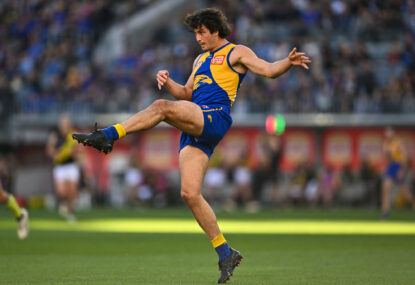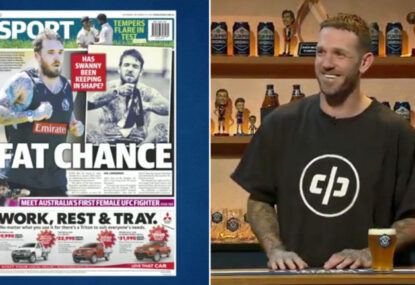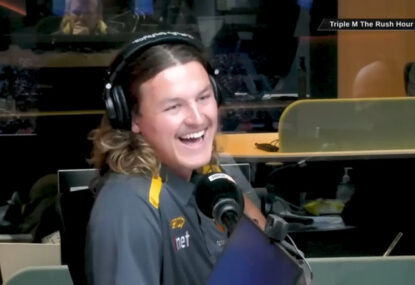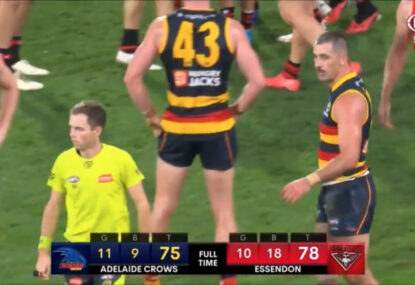We move now to the L team, with firepower enough up front to outscore almost anyone.
Back line
Wes Lofts (Carlton 1960-70)
167 games, 65 goals
Wes Lofts was a rugged and determined defender for Carlton throughout the 1960s. Although he played at centre half back in the losing 1962 grand final, it was on the last line of defence that he starred. Lofts was one of the biggest defenders of the era, and represented Victoria in 1963 and 1967, finishing runner up in Carlton’s best and fairest award in 1966. In 1968, Lofts played in a drought-breaking flag for the Blues, and missed out on a second flag in 1970 after being dropped on the eve of the finals due to a poor match-up with Peter McKenna. He retired after the season to become an off-field power broker for the Blues up until the mid 2000s.
Chris Langford (Hawthorn 1983-97)
303 games, 33 goals
A solid and dependable Hawk at full back, Chris Langford started his career as a back-up ruckman before shifting to full back. He played in four premierships and was named All Australian on four occasions. In an era of dominant forwards Langford held his own with immense strength and plenty of skill overhead and at ground level. He was a regular representative in Victorian State of Origin sides, and captained Hawthorn in 1994. In 1996, Langford’s defiant gesture in raising his jumper to the crowd after the merger game against Melbourne inspired Hawks fans to vote against the proposed merger. Langford was named on the interchange bench of Hawthorn’s Team of the Century.
Harry Lever (St Kilda 1905-15, 1918-19, 1921-22)
218 games, six goals
Harry Lever was a mainstay in defence for St Kilda over a period of 15 years, missing the 1916-17 seasons when the Saints disbanded for World War I and 1920 when he played with Brighton in the VFA. He was best noted for his prodigious kicking out from full back, and once kicked 72 yards with a place kick. In 1907, Lever cut off two fingers in a bandsaw accident, but bandaged the wound himself and still turned out for the Saints that weekend. When he retired, Lever held the games record for St Kilda and would not be surpassed until 1972.
Half back line
Peter Lucas (Collingwood 1949-59)
177 games, one goal
Peter Lucas could have played for St Kilda, where his father George spent five years in the 1920s. But the Saints showed no interest, to Collingwood’s benefit. Lucas would go on to be a talented yet unobtrusive half back flanker who would occasionally move to centre half back. Pacy, skilled and with great anticipation, he was unlucky enough to miss out on both the 1952 and 1953 grand finals. However, Lucas made amends in 1958 by featuring in the famous boilover flag of that year. Twice he was runner up in the club’s best and fairest awards. As with L teammate Wes Lofts, he would go on to a long career behind the scenes at his club, serving as Collingwood general manager through the 1970s.
Justin Leppitsch (Brisbane 1993-2006)
227 games, 194 goals
Justin Leppitsch started his career in the forward line, recovering from a knee reconstruction in his first year to lead the club’s goal-kicking in 1997 and 1998. However, upon the arrival of coach Leigh Matthews, Leppitsch shifted to the back line where he became a noted physical presence who would repel attacks as a matter of course. In 1999 he won the club best and fairest award, before featuring in each of Brisbane’s three premierships. Named All Australian on three occasions, Leppitsch struggled with injury through 2005 and 2006 before retiring.
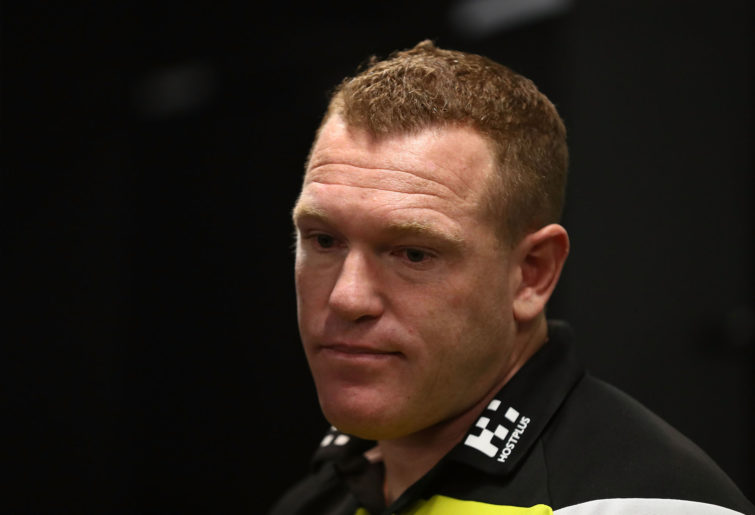
(Photo by Robert Cianflone/Getty Images)
Brett Lovett (Melbourne 1986-97)
235 games, 48 goals
Brett Lovett spent three years toiling away in Hawthorn’s reserves team before transferring to Melbourne, where he would stand out as a steady and dependable presence at half back for 12 years. He represented Victoria from 1998-91, finishing in equal fourth in the Brownlow Medal in 1990. In 1988 Lovett was recognised as one of the best Melbourne players on the field during their ill-starred grand final appearance, and continued through the 1990s with varying effectiveness until retiring during the 1998 season.
Centre line
Nigel Lappin (Brisbane 1994-2008)
279 games, 174 goals
One of the ‘Fab Four’ of Brisbane’s midfield, Nigel Lappin was an unobtrusive yet effective operator for the Lions. Consistent and able to both win the ball and use it with effectiveness, Lappin represented Victoria in 1996, 1997 and 1999 before being part of the club’s three premierships. His determination to play in the 2003 grand final with a broken rib and punctured lung has entered Brisbane folklore. In 2004, Lappin won his only best and fairest award, before an ankle injury prematurely ended his 2005 season and wiped out 2006 completely. In 2007, he was named as Brisbane captain, before retiring in 2008. Lappin was named on the wing in Brisbane’s Team of the Decade.
Allan La Fontaine (Melbourne 1932-42, 1945)
171 games, 77 goals
Before joining Melbourne, Allan La Fontaine was a dominant full forward in the VAFA. In his second game with Melbourne he carried on to kick nine goals, but eventually found fame as a centreman of great repute. La Fontaine was named captain in 1936 and held the role until 1941, taking part in Melbourne’s three straight premierships of 1939-41. Elusive and fast, his ability to dodge trouble saw him a Victorian representative and four time best and fairest award winner and twice runner up in the Brownlow Medal. After the 1942 season, La Fontaine joined the RAAF for two years, returning for one last season in 1945. He was a clear choice as centreman in Melbourne’s Team of the Century.
Michael Long (Essendon 1989-2001)
190 games, 143 goals
After dominating the NTFL for St Marys and finished third in the 1988 Magarey Medal, Michael Long moved across to Essendon and quickly built a reputation as a flashy and creative wingman with pace to burn. Never was this better showcased than when he was touched by greatness in the 1993 grand final, winning the Norm Smith Medal with a dominant performance. Another premiership followed in 2000 before Long retired after being unable to prove his fitness for the 2001 grand final. He finished fourth in the Brownlow Medal in 1995, the same year he spoke out about racist taunts on the field. Since retirement Long has been a spokesman for Indigenous affairs.
Ruck line
Geoff Leek (Essendon 1951-62)
191 games, 98 goals
Geoff Leek had a reputation as one of the finest palmers of the ball throughout the 1950s, giving his rovers first use of the ball with regularity. Although his kicking was not of the highest standard, he was a towering presence on the field and named vice captain for the last six years of his career. In 1952, Leek enjoyed the novelty of being named as the tallest man in the VFL, a half inch ahead of eight other ruckmen. His final year saw him take part in the 1962 premiership, having had to pass a fitness test on his injured ankle before the game. Kicking a heavy medicine ball hard enough to impress the selectors, Leek never let on that he had been kicking with his non-injured foot!
Jordan Lewis (Hawthorn 2005-16, Melbourne 2017-19)
319 games, 161 goals
Hawthorn’s midfield enforcer for over a decade, Jordan Lewis played in all four of the Hawthorn premierships during his time with the Hawks. Tough and uncompromising, Lewis was a consistent ball winner who could go the other way when necessary. He was named All Australian in 2014, the same year he won Hawthorn’s best and fairest award. After the 2016 season, Lewis was traded to Melbourne, where he shared his experience with the young Demons and helped them reach the preliminary final in 2018.
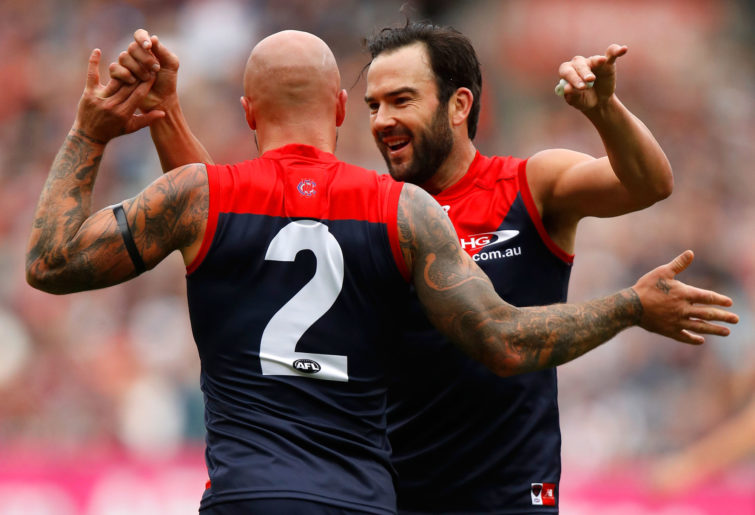
(Photo by Michael Willson/AFL Media/Getty Images)
Tony Liberatore (Footscray 1986-2002)
283 games, 95 goals
Only one player has won the Morrish (under-19s), Gardiner (reserves) and Brownlow Medals – Tony Liberatore achieved this in 1984, 1986 and ’88 and 1990 respectively. His 1990 Brownlow Medal came as a shock, as he had played only 18 games in four seasons to the start of the year, but he backed it up by winning Footscray’s best and fairest award in 1991. Throughout the 1990s Liberatore was a consistent presence in the midfield for Footscray, known just as much for his tagging ability as what he did when he got the ball. By the time he retired in 2002, he had amassed well over 1000 tackles, being the first player to reach 100 tackles in a season in 1992. Liberatore was named on the bench in Footscray’s Team of the Century and in the Italian Team of the Century.
Half forward line
Chris Lewis (West Coast 1987-2000)
215 games, 259 goals
Chris Lewis’ talent was such that he was included in West Coast’s squad after only a handful of WAFL games as a 17-year-old. He continued to play for the Eagles up until 2000, as a temperamental but brilliant forward, capable of the spectacular while also not beyond reacting to abuse and getting suspended. Lewis played in the 1992 and 1994 premierships, and was named as club best and fairest in 2000. A regular feature in WA sides for State or Origin matches, he also won a WAFL premiership while still on the Eagles’ list in 1996. Lewis was named on the half forward flank in West Coast’s 20th Anniversary team, and the forward pocket of the Indigenous Team of the Century.
Stewart Loewe (St Kilda 1986-2002)
321 games, 594 goals
On his retirement, Stewart Loewe had hauled in the most marks in VFL/AFL history – 2503 across 321 matches primarily at centre half forward. Incredibly fit and with a natural set of hands, he led St Kilda capably throughout the 1990s and captained them to a grand final in 1997. Loewe led St Kilda’s goal-kicking in 1995 and 1996, and won a best and fairest award in 1990 to go with four runner up placements. He was also a perennial member of Victorian State of Origin sides, representing the Big V in every year from 1990-98 with the exception of 1994. Loewe was named on the half forward flank of St Kilda’s Team of the Century.
Matthew Lappin (St Kilda 1994-98, Carlton 1999-2007)
251 games, 247 goals
Matthew Lappin was a talented if inconsistent player with St Kilda, playing in the 1997 grand final but never making any great impression with the Saints. It took all of one match for him to make a name for himself in navy blue, soaring above a pack to win Mark of the Year in Round 1! At Carlton, Lappin was a crafty small forward, who led the club’s goal-kicking in 2001 and twice finished third in the club’s best and fairest award. As the Blues fell backwards, he was deployed as a rebounding defender, where his skill and courage saw him attain All Australian selection in 2004. Lappin played in three International Rules series before injury forced retirement in 2007 – at least until 2015, when he had to play as a top up in the Gold Coast reserves team!
Forward line
Matthew Lloyd (Essendon 1995-2009)
270 games, 926 goals
Drafted by Essendon as a 16-year-old, Matthew Lloyd was a dominant full forward from the late 1990s through to his retirement. Twelve times he led the Bombers’ goal-kicking, and three times he was a Coleman Medallist. With vice-like hands and an ability to kick goals from well outside 50, Lloyd was a premiership player in 2000 and won both Mark and Goal of the Year during his career. His dominance and mannerisms were such that he was credited with the necessity of introducing the shot clock for set shots after one too many grass tosses. Lloyd was named as number 22 in the Champions of Essendon in 2002, and had that list been revised at the end of his career he would surely have been higher.
Tony Lockett (St Kilda 1983-94, Sydney 1995-99, 2002)
281 games, 1360 goals
The greatest goal kicker in VFL/AFL history, Tony Lockett was a lock for full forward in this team. Physically imposing, with a strong mark and devastating accuracy, Lockett led St Kilda’s goal-kicking in all but two seasons before shifting to Sydney and leading the goal-kicking there for each season barring an abortive comeback. There was more to his game than goals, as evidenced by three club best and fairest awards as well as a Brownlow Medal in 1987. Curiously, despite his record-breaking career, Lockett is possibly best known for a behind – an after-the-siren effort to launch the Swans into the grand final in 1996, their first for 51 years. Lockett has an end named for him at Marvel Stadium, and is full forward in both St Kilda’s and Sydney’s Team of the Century.
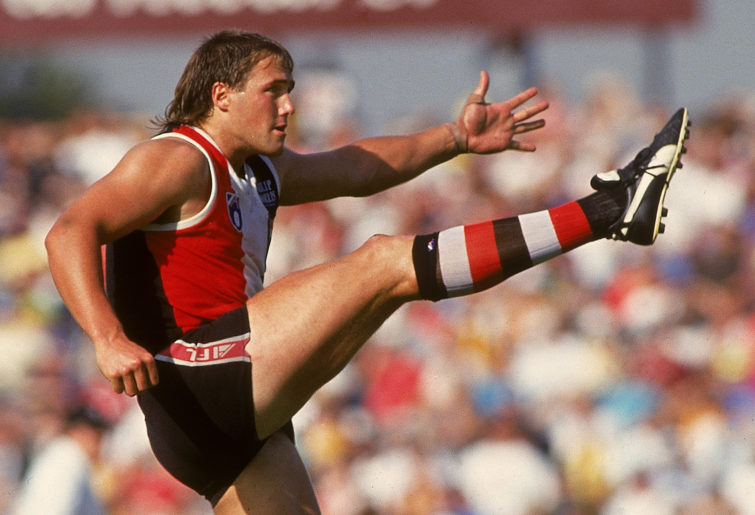
(Photo by Getty Images)
Mark LeCras (West Coast 2005-18)
219 games, 441 goals
A creative and deft player in West Coast’s forward line, Mark LeCras took some time to cement himself in a strong Eagles line-up before breaking out with 58 goals in 2009 to lead the club’s goal-kicking. The following year, he kicked 12 goals against Essendon on his way to 63 for the year, All Australian selection and a best and fairest award. In 2012 LeCras injured his knee, requiring a reconstruction, and he returned to form throughout 2013 and 2014 before featuring in the 2015 grand final. In his final years his football nous was still held in good regard by the Eagles hierarchy, and he played in West Coast’s 2018 premiership before retiring.
Interchange
Brian Lake (Western Bulldogs 2002-12, Hawthorn 2013-15)
251 games, 34 goals
Brian Lake entered the league as Brian Harris before changing his name to match his father’s on the birth of his first son in 2010. By then he had developed a reputation as a tough physical competitor, often having the better of opposing forwards with his anticipation and aerial strengths. In 2007 Lake won a club best and fairest award, and he was named All Australian in 2009 and 2010 before crossing to Hawthorn with the aim of playing in a premiership. This he achieved on three successive occasions, winning the Norm Smith Medal in 2013. After his third premiership in 2015, Lake retired and went on to compete in the 2018 season of Australian Survivor, finishing third.
Alastair Lynch (Fitzroy 1988-93, Brisbane 1994-2004)
306 games, 633 goals
Lynch could play at both ends of the ground, first playing as a full back for Fitzroy and Tasmania before shifting to full forward later in his career. With excellent marking ability (highlighted by his 1989 Mark of the Year) and relentless physical determination, Lynch was recognised as one of the toughest defenders to play on in the early 1990s. When he moved to full forward, he led Fitzroy’s goal-kicking and won their best and fairest in 1993 before a ten-year contract lured him north to Brisbane. After recovering from chronic fatigue syndrome, Lynch was a powerhouse up forward, leading the club’s goal-kicking five times and playing in the premiership three-peat of 2001-03. He retired in 2004 after the grand final loss, and was named on the interchange bench of Fitzroy’s Team of the Century.
Cameron Ling (Geelong 2000-11)
246 games, 139 goals
Cameron Ling was an immediately identifiable part of Geelong’s premiership winning sides of 2007, 2009 and 2011, with his shock of red hair roaming around the midfield and most often sticking to an opponent like glue. As a tagger Ling developed a reputation as a disciplined player who was capable of getting under opponents’ skin, before he started to win more of his own ball and a best and fairest award in 2004. Ling was named All Australian in 2007 and captained the club in 2010 and 2011. In all but his first two seasons, Ling played over 20 matches, showcasing his endless consistency.
Tarkyn Lockyer (Collingwood 1999-2010)
227 games, 149 goals
As Collingwood rebounded from a wooden spoon to contenders in the early 2000s, Tarkyn Lockyer was an underrated member of the squad rotating through the midfield and half back. In his second season he finished as runner up in the best and fairest award, and was a reliable player when on the field. Lockyer played in the 2002 grand final, but missed the 2003 rematch after injuring his ACL early in the season. As Collingwood rose again towards the end of the decade he featured prominently in the club’s finals campaigns before losing his spot in 2010 to introduce youth as Collingwood would win that elusive flag.

(Photo by Michael Dodge/AFL Media/Getty Images)
Emergencies
Dick Lee (Collingwood 1906-22)
230 games, 707 goals
Dick Lee was probably the first truly great goal kicker in VFL history, with freakish marking ability and unerring accuracy enabling him to lead the league on seven occasions and Collingwood in 11 seasons. He suffered from some bad luck with injuries – a gashed shin in 1908 that would open every week and a knee injury necessitating cartilage removal in 1912 the most prominent. Lee’s 66 goals in 1915 were a league record in the first 25 years of the VFL. He captained Collingwood in 1920 and 1921, and played in the 1910, 1917 and 1919 flags. Dick Lee was named on the half forward flank of Collingwood’s Team of the Century.
Scott Lucas (Essendon 1996-2009)
270 games, 471 goals
Capable of holding down a key position at either end of the field, it was at centre half forward that Scott Lucas was most notable. With a booming left foot kick (and indeed a reputation for always swinging onto that left leg) he was capable of kicking goals from 60 metres or deftly passing to teammates in a better position. Lucas won best and fairest awards in 2003 and 2006, leading the club’s goal-kicking in the latter year. His most notable performances came in 2001, where he kicked the ball for Gary Moorcroft’s Mark of the Year, and in 2007, when he kicked seven goals in the last quarter to almost singlehandedly get Essendon over the line in James Hird’s farewell match.
Johnny Lewis (North Melbourne 1925-35, Melbourne 1936-38)
196 games, 160 goals
Johnny Lewis was one of the first great players for North Melbourne after the joined the VFL, as a tough ruckman who was never shy about throwing his weight around. He led North’s goal-kicking in 1931 and 1935, also winning the club best and fairest that year in spite of suggestions he retire from the game. Instead, he transferred to Melbourne and gave the club good service for three years before retiring due to a broken arm. Despite his tough reputation, Lewis was a sportsman as well – ordering one of his rovers off the field to even things in Round 5, 1933, when St Kilda had suffered such injuries to have only 15 fit players on the field. His great grandson, Daniel Venables, is currently playing with West Coast.
Up next is the M team, with a player seen as one of the best of the 19th century as well as the best of the 20th century.

































































































